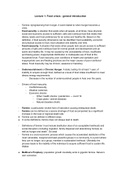Lecture 1: Food crises - general introduction
- Famine: dying/starving from hunger. A word related to when hunger becomes a
crisis.
- Food security: a situation that exists when all people, at all times, have physical,
social and economic access to sufficient, safe and nutritious food that meets their
dietary needs and food preferences for an active and healthy life. Based on this
definition, 4 food security dimensions can be identified: food availability, economic
and physical access to food, food utilization and stability over time.
- Food insecurity: A situation that exists when people lack secure access to sufficient
amounts of safe and nutritious food for normal growth and development and an
active and healthy life. It may be caused by the unavailability of food, insufficient
purchasing power, inappropriate distribution or inadequate use of food at the
household level. Food insecurity, poor conditions of health and sanitation and
inappropriate care and feeding practices are the major causes of poor nutritional
status. Food insecurity may be chronic, seasonal or transitory.
- Undernourishment or Chronic Hunger: A state, lasting for at least 1 year, of
inability to acquire enough food, defined as a level of food intake insufficient to meet
dietary energy requirements.
- Decrease in the number of undernourished people in Asia over the years.
- Drivers of food insecurity:
- Conflict/insecurity
- Weather extremes
- Economic shocks
- Other: health shocks / pandemics → covid 19
- Crops pests / animal diseases
- Natural disasters (Haiti)
- Famine: a particularly virulent form of starvation causing widespread death.
- Famine can be defined as a severe shortage of food accompanied by a significant
increase in the local or regional death rate.
● Famine can be defined in different ways.
● In some definitions, famine does not always lead to death.
- Definitions of famine “must include destitution (loss of an acceptable livelihood) and
social disruption (including migration, family dispersal and abandoning homes) as
well as hunger and death”. De waal
- Famine is a socio-economic process which causes the accelerated destitution of the
most vulnerable, marginal and least powerful groups in a community, to a point where
they can no longer, as a group, maintain a sustainable livelihood. Ultimately the
process leads to the inability of the individual to acquire sufficient food to sustain life.
Walker.
● Malthus’s Prophecy: population growth inevitably ends in gigantic famine. Nature’s
own correction.
,Decrease in people that die from famine, as they rather die from diseases (cholera for
instance, as they travel to other places to find food). Malthus’s Zombie.
, Lecture 2: Food and crisis: terms, measurements and responses
- Crisis: an event, concentrated in time and space, which threatens a society or
relatively self-sufficient subdivision of society with major unwanted consequences as
a result of the collapse of precautions which had hitherto been culturally accepted or
adequate. (Turner 1976).
- Outside event befalling societies, requiring outside intervention: an emergency is not
expected to have ways of dealing with itself. (De Waal 1989).
Hunger crises are the result of environmental, political and economic circumstances, but do
we understand hunger as social experience?
● “The way one conceives of the empty stomach is a crucial determinant of how one
acutally treats it.” (Tom Scott-Smith, 2020).
Physical responses to food crises:
- Acute wasting, stunting, starvation.
- Vulnerability to infectious disease.
- Kwashiorkor: insufficient protein intake with sufficient energy (swollen bellies).
- Marasmus: insufficient energy intake.
- Numerous lasting physical and cognitive effects of prolonged deficiencies of vitamins,
minerals, etc, i.e..: stunting, lack of learning, low health in babies.
Studying hunger:
Bio-ecological (technical interpretation)l:
● Neo-Malthusian explanation: malnutrition and chronic hunger as are part of
adaptation.
● Stunting = adaptation to be able to survive on less.
● Pygmytization.
Symbolic interpretation:
● Food as organizing social relations: looking at the role of food in society and relation
to power.
● “The soup kitchen was based on a very moralizing attitude to huner: a belief that it
was not simply bad luck that led to starvation, but a moral failing. This made the soup
kitchen far more…
Preventive mechanisms (‘O Grada 2008):
- Postponing marriage, postponing childbirth.
- Slavery-servitude...temporary pawning of children
- Prostitution
- Child abandonment ‘selective neglect’.
- Infanticide - duty to save the elder member of the family.
- Cannibalism
Stages in the famine process (Walker):
a. Overcoming normal seasonal stress (rationing food, diversifying income).
, b. Increasingly irreversible strategies such as selling breeding livestock, mortgaging
land, ‘trading short-term gain for long-term problems’.
c. Dependence on external support (food aid).
d. Starvation and death.
But when needs an intervention to take place?
Stages in response to hunger (Thomas):
● Exploration
● Retrenchment
● Exhaustion





